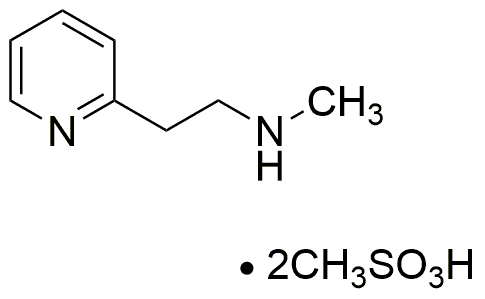Betahistine methanesulfonate is widely utilized in research focused on:
- Treatment of Vestibular Disorders: It is primarily used to alleviate symptoms of Meniere's disease and other vestibular disorders, helping patients manage vertigo and balance issues effectively.
- Pharmaceutical Development: Researchers explore its pharmacological properties to develop new formulations that enhance bioavailability and patient compliance, particularly in oral dosage forms.
- Neuroscience Research: It is studied for its potential neuroprotective effects, contributing to research on conditions such as tinnitus and other auditory processing disorders.
- Clinical Trials: The compound is frequently involved in clinical trials aimed at assessing its efficacy and safety, providing valuable data for healthcare professionals and regulatory bodies.
- Combination Therapies: It is investigated for use in combination with other medications to improve therapeutic outcomes for patients with complex conditions, offering a more holistic approach to treatment.
Informations générales
Propriétés
Sécurité et réglementation
Applications
Betahistine methanesulfonate is widely utilized in research focused on:
- Treatment of Vestibular Disorders: It is primarily used to alleviate symptoms of Meniere's disease and other vestibular disorders, helping patients manage vertigo and balance issues effectively.
- Pharmaceutical Development: Researchers explore its pharmacological properties to develop new formulations that enhance bioavailability and patient compliance, particularly in oral dosage forms.
- Neuroscience Research: It is studied for its potential neuroprotective effects, contributing to research on conditions such as tinnitus and other auditory processing disorders.
- Clinical Trials: The compound is frequently involved in clinical trials aimed at assessing its efficacy and safety, providing valuable data for healthcare professionals and regulatory bodies.
- Combination Therapies: It is investigated for use in combination with other medications to improve therapeutic outcomes for patients with complex conditions, offering a more holistic approach to treatment.
Documents
Fiches de données de sécurité (FDS)
La FDS fournit des informations de sécurité complètes sur la manipulation, le stockage et l’élimination du produit.
Spécifications du produit (PS)
Le PS fournit une description complète des propriétés du produit, notamment sa composition chimique, son état physique, sa pureté et les exigences de stockage. Il détaille également les plages de qualité acceptables et les applications prévues du produit.
Certificats d'analyse (COA)
Recherchez des certificats d'analyse (COA) en saisissant le numéro de lot du produit. Les numéros de lot et de lot se trouvent sur l'étiquette d'un produit, après les mots « Lot » ou « Lot de fabrication ».
Numéro de catalogue
Numéro de lot/série
Certificats d'origine (COO)
Ce certificat d'exploitation confirme le pays dans lequel le produit a été fabriqué, et détaille également les matériaux et composants utilisés et s'il est issu de sources naturelles, synthétiques ou autres sources spécifiques. Ce certificat peut être requis pour les douanes, le commerce et la conformité réglementaire.
Numéro de catalogue
Numéro de lot/série
Fiches de données de sécurité (FDS)
La FDS fournit des informations de sécurité complètes sur la manipulation, le stockage et l’élimination du produit.
DownloadSpécifications du produit (PS)
Le PS fournit une description complète des propriétés du produit, notamment sa composition chimique, son état physique, sa pureté et les exigences de stockage. Il détaille également les plages de qualité acceptables et les applications prévues du produit.
DownloadCertificats d'analyse (COA)
Recherchez des certificats d'analyse (COA) en saisissant le numéro de lot du produit. Les numéros de lot et de lot se trouvent sur l'étiquette d'un produit, après les mots « Lot » ou « Lot de fabrication ».
Numéro de catalogue
Numéro de lot/série
Certificats d'origine (COO)
Ce certificat d'exploitation confirme le pays dans lequel le produit a été fabriqué, et détaille également les matériaux et composants utilisés et s'il est issu de sources naturelles, synthétiques ou autres sources spécifiques. Ce certificat peut être requis pour les douanes, le commerce et la conformité réglementaire.


